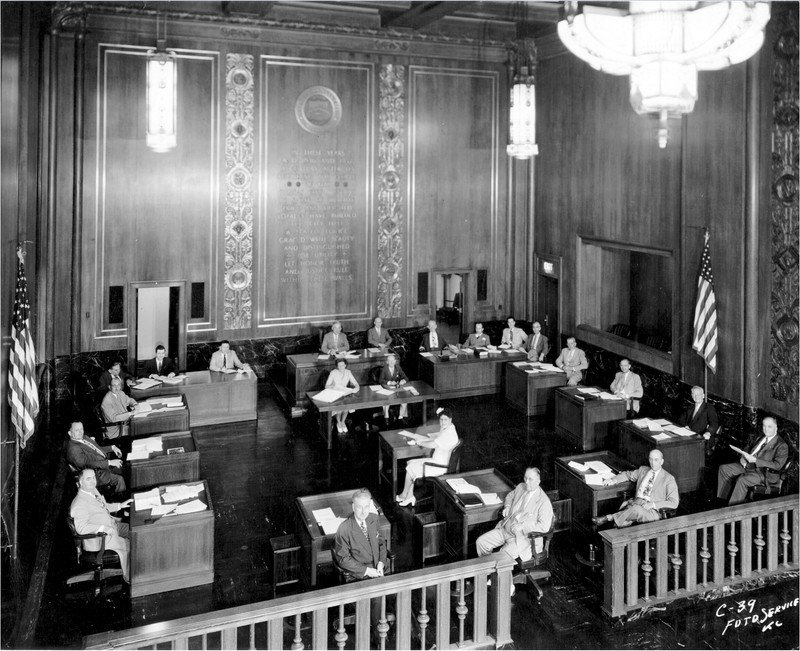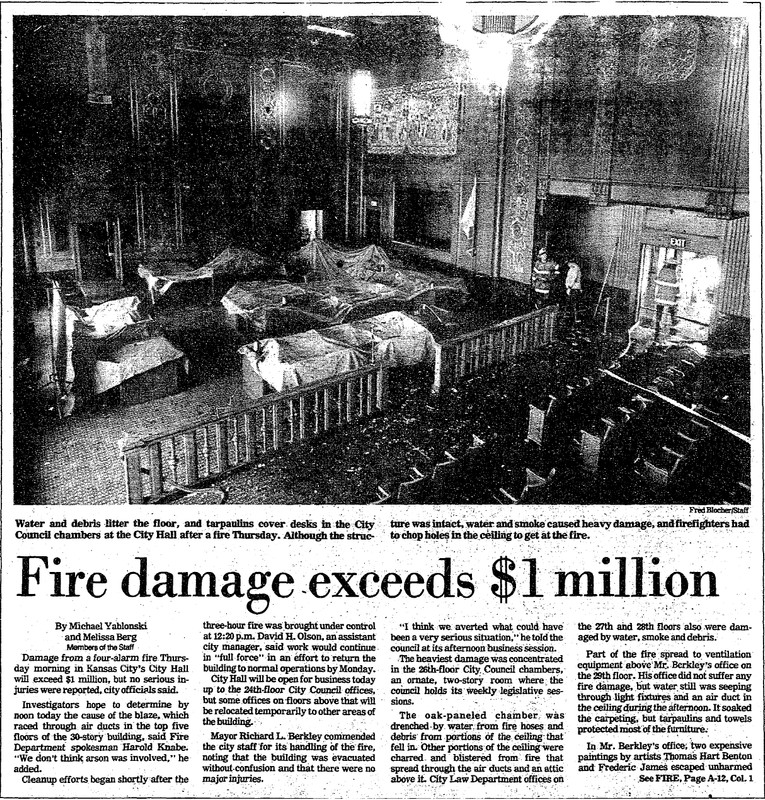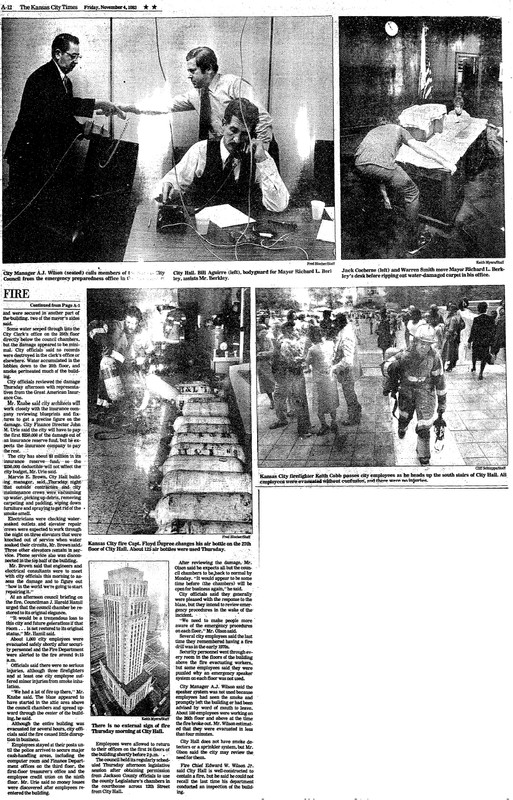26th Floor - Council Chamber
Introduction
Text-to-speech Audio
This is where the action happens. The Council Chamber is home to most of the legislative activity that takes place in City Hall. Committee meetings and full council session regularly take place in this ornately decorated, stately chamber. There are 13 desks for the Mayor and Councilmembers as well as an area for the City Clerk and staff. In addition, the chamber is updated for video and audio livestreaming as well as virtual communications for public comment.
Images
Inside Council Chamber - Late 1930s

Fire damage exceeds $1 million - KC Star

Fire damage exceeds $1million (Continued) - KC Star

Backstory and Context
Text-to-speech Audio
When it was constructed, the 26th Floor Council Chamber reflected a recent change to the City Charter. In 1925, a political reform movement was successful in altering the City Charter to change the legislative structure to a Council/Manager form of government (Your City Hall; McFerrin). This change is still reflected in the structure of the City’s government today as there is a 12-member council (6 in-district, 6 at-large) with the Mayor as presiding officer. The City Manager serves as the chief administrator of City operations and is responsible for the outcomes of all City departments and services.
The Council Chamber features some impressive design and ornamentation. The walls have an Oak veneer paneling with antiqued white bronze arabesques as separators. Each of the 150 veneer panels rises, unbroken, twenty-one feet and ten inches from a wainscot of Verde Antique marble sourced from Vermont. At the time of construction, these panels represented one of the largest veneer jobs ever undertaken. In fact, the panels were so large that there were no veneer presses that could fit them, and each panel had to be worked by hand. Surprisingly, all of the panels are the product of a single, enormous Oak tree harvested in upstate New York (Your City Hall).
In November of 1983 a fire in the ductwork and ventilation systems of the top several floors of City Hall caused damage to the Council Chamber resulting from a combination of smoke, water and debris. The veneer had to be stripped and resealed and all of the upholstery was professionally cleaned. At the time, Councilmember J. Harold Hamil advocated the full restoration of the Council Chamber and remarked, “It would be a tremendous loss to this city and future generations if that room . . . is not restored to its original status,” (Yablonski and Berg).
Residents and members of the general public are welcome to attend sessions in the Council Chamber, and ample seating is provided on the 26th floor level as well as in the balcony above.
Cite This Entry
Jenkins, Michael. "26th Floor - Council Chamber." Clio: Your Guide to History. September 7, 2021. Accessed August 11, 2025. https://theclio.com/entry/10918/tour/4/reverse
Sources
McFerrin, Ann. City Hall Profile | KC History. 1999, https://kchistory.org/document/city-hall-profile?solr_nav%5Bid%5D=fe9be84d325c2f9d8f40&solr_nav%5Bpage%5D=0&solr_nav%5Boffset%5D=0&search=Ann%2520McFerrin%2520and%2520%2522city%2520hall%2522.
Yablonski, Michael, and Melissa Berg. Fire Damage Exceeds $1 Million, Kansas City Times (Published as The Kansas City Times), November 4, 1983, P1,12. 4 Nov. 1983, https://infoweb-newsbank-com.mcpl.idm.oclc.org/apps/news/document-view?p=WORLDNEWS&t=&sort=YMD_date%3AD&fld-base-0=alltext&maxresults=20&val-base-0=%22November%204%2C%201983%22%20and%20%22fire%20damage%22&docref=image/v2%3A11FF2A92A519802A%40EANX-NB-1677E0DC8A08FA39%402445643-1677515A8295BB2F%400-1677515A8295BB2F%40.
“Your City Hall” brochure, 1937. City Hall, 12th Street | KC History, Vertical File, Missouri Valley Special Collections, Kansas City Public Library https://kchistory.org/index/city-hall-12th-street?solr_nav%5Bid%5D=ec3ed13ce4ab73476ca7&solr_nav%5Bpage%5D=0&solr_nav%5Boffset%5D=7. Accessed 30 Aug. 2021.
The City of Kansas City, Missouri - Communications Department
The Kansas City Star
The Kansas City Star

